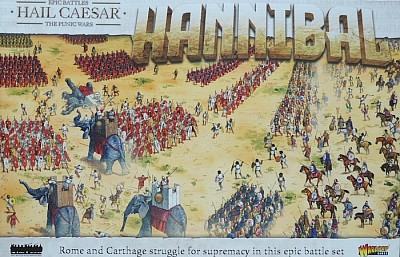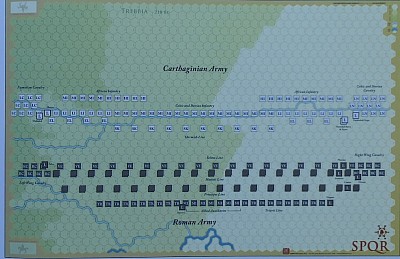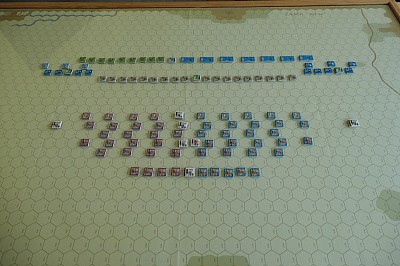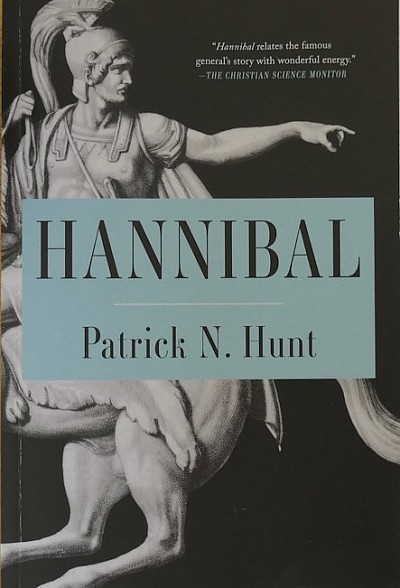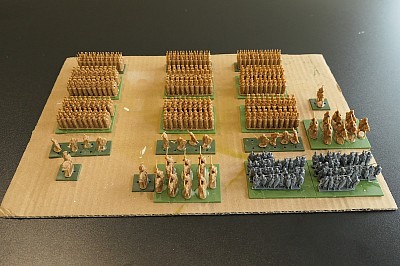The Trebbia Project 218 BC
Introduction
I’m sure this must be the case with most wargamers, but I have a small list of battles that will always grab my attention, favourites if you like and for no particular reason that I can fathom, Trebbia 218 BC is one of them.
Many years ago, I delved into a creating 2mm forces for both sides, specifically to service this battle, a project that was completed, but somehow has become lost to the mists of time!
Inspired by the latest Epic scale release from Warlord Games with their Punic War range, here we are again, planning a Trebbia game. This time it will not just be figures on the table, but also a boardgame. SPQR Deluxe (the modern re-print) from GMT (The Great Battles of History series) has what appears to be a very nice rendering of the battle, but is a few years since I have played it.
So this project page will be dedicated to getting Trebbia to the table, in both of its forms, figure game and boardgame. The latter will likely make it first, as it is a simple case of punching counters and reading rules, whereas the Epic figures do require building and while painting is not essential, it would be nice to see at least some ‘dressed up’ with somewhere to go!
The Epic set comes with its own fast play boardgame system, so no doubt that will also get an airing.
The Battle of Trebbia.
Hannibal Barca Vs Roman Consul T. Sempronius Longus. The first major battle of the Second Punic War - Northern Italy, December 218 BC.
This is the battle that resulted from Hannibal’s amazing crossing of the Alps. His move down into the Po Valley took the Romans by surprise and they had to significantly and urgently re-locate armies to meet the threat.
The Trebbia is a river in Italy and in our games, it will run the full width of the table, with the Carthaginians on the west side and the Romans on the east side.
Essential elements of the battle are that;
It is winter and very cold. Sempronius, the Roman commander is determined to fight the enemy. He wants a victory before his office as Consul comes to an end in a few weeks. This sees his army crossing the freezing waters of the river. Such was the rush to action, that the Romans did not take time to have a breakfast.
They crossed the water and once out on the other side, dripping wet and facing a fully deployed Carthaginian army, the chilled temperatures and lack of a good breakfast brought about an exhaustion and loss of morale to the Roman force, immediately disadvantaging them.
Additionally, the Carthaginians had set a trap. Mago, younger brother of Hannibal, had been told to take 2000 men and set up an ambushing force downstream in a defile.
The Roman army was, perhaps unsurprisingly, significantly beaten and driven back across the Trebbia. Their losses are thought to be around 20,000.
A Roman player may need some fortitude to play the hand dealt to them by history!
Epic Trebbia
The Hail Caesar rule book that comes with the Epic package, has a goodly number of scenarios, many intended for the 6’ x 4’ table and happily amongst that count is a Trebbia scenario.
In addition to the setting the table as the per the map, between 3 - 5 low impact terrain features are also randomly added (hills, woods and rough ground etc). The idea here is for the Carthaginian to secretly deploy the Mago ambush to one of those features - a good way to deal with the Roman player knowledge that there will be an ambush force …. somewhere!
Great Battles of History (GBoH) Trebbia
The SPQR deluxe version of the boardgame gives us a dedicated map for the Trebbia game. Note this is the set-up diagram from the rulebook, the actual game counters themselves are in full colour.
The GBoH system is fairly detailed, however some years ago, GMT brought out a simplified version of the core rule book amounting to just 14 pages. This streamlines several process and reduces the total number of die rolls made over the course of a game (this solo player says thank-you!).
A direct fall-out from the simplification is that the playing time of many of the scenarios have been halved. The estimate playing time using the standard rules states ‘a single sitting’ (that must be a long sitting is all I can say), while the simplified rules estimate a game of around 3 hours.
Obviously the situation is pro Carthaginian and so there is a balancing rule of replacing the Depleted legions with fresh ones and / or bringing in Scipio as overall Roman commander. I will not be using the balancing rules, preferring the historical setting, at least for a first playing.
The Depletion rules represent the poor health (near hypothermia) and morale of the Roman troops after crossing the Trebbia.
The Velites (Roman skirmishers) were heavily involved in pre-skirmishing with enemy cavalry and so by the time of battle, had already discharged most of their pila, so during the game, for any ranged shooting, they roll for either missile ‘low’ or ‘none’!
Preparations
Before going straight to the Trebbia scenario, I have put the Bagradas scenario on the table, which they suggest is a good introductory scenario for learning the rules, but it also heavily favours the Carthaginians
An important bit of learning to come out of this is how elephants should be handled, both by their owners and thos that have to face them!
Good battle by battle guide
Since buying the Epic Hannibal box set, I have been on the lookout for a good complimentary read. The various Roman history sections in book shops are quite good on first glance, but there seems to be a gap when it comes to the Punic Wars and more surprisingly on one of history’s great figures …. Hannibal.
Anyway, today in one of the large Waterstone Stores (UK), I came across this gem, Hannibal by Patrick Hunt, published by Simon & Schuster.
These things have the potential to be a bit heavy going, but on first glance, this is very readable and presented very much as a wargamer friendly book.
There is a brief introduction to Hannibal and the geo-political setting. From there-on-in, the book flows through the initial crossing of the Alps and in effect becomes a chain of accounts of all of relevant battles.
This presentation style allows the reader to read through the text from start to finish, following the journey and life of Hannibal or it can be a ‘pick up - put down’ book with the reader just accessing the particular chapter that covers the battle that interests them.
If we take as example my immediate interest in the Trebbia battle, it is covered by Chapter 11 with 12 pages of description. There is a helpful black and white map and useful sub-headings such as ‘Reconnoitering the battle site’ and ‘Trebia River as a weapon’. It certainly is enough to put the meat on the bones as a pre-read to putting a game on the table.
The back cover has the typical review snippets and I thought this probably said it all “Particularly illuminating in discussing Hannibal’s famous crossing of the Alps in 218 B.C. … Hunt excels in his descriptions of the battles” Thomas E. Ricks, The New York Times Book review.
Inspiring work by a YouTuber
You MUST have a look at this bloke’s video. A very imaginative way to use the recent Punic Wars Epic figures from Warlord Games.
He has cut some of the bases and re-organised them for a much better organic look and this is certainly the way that I am now thinking about for my own armies, including a re-think on how I am presenting some of the other periods.
LINK
A Roman order of battle for Trebbia
I have cut enough Roman troops from their sprues to represent their order-of-battle as described in the Trebbia scenario from the Hail Caesar rulebook.
But, I have taken a non-Warlord Games approach to this and as recently discussed, have instead adopted the basing style that ‘Scotty’ described in his recent YouTube video - see link at the foot of this post.
So, a few things need to be said about this. Firstly I will be going with 80mm frontages, but here, I have initially mounted the units on 60mm bases. This is because while they are unpainted, I am using a temporary fixative and it will be easier to remove the troops for painting, from plastic bases than from my MDF bases and I only have 60mm bases in plastic (taken from the Perry 28mm boxes).
The Celt warband will need a couple of extra strips worth of troops, plus some singles, once they move to 80mm bases to ensure that the base is pleasingly filled.
The current basing will have a pretty big impact on reducing the needed table size. Most of the scenarios are designed for a 6x4, though some of the biggies, for example Zama, recommend a 10 foot table. Our reduced frontages, even when grown to 80mm, should significantly bring that down.
The only thing I still need to add to the Romans for the Trebbia battle is a Generals base. I have the figure, I just need to do it, my delay is in deciding what to use as a supporting figure on the base.
So what do we have?
Using the terminology from the Epic rule book, we divide the Roman force into three ‘divisions’.
Referring to the photo above, starting at the bottom and working up the column - On the left is the first division. This has 1 x Velites, 1 x Hastati, 1 x Principes and 1 x Triarii, plus a commander.
In the centre is the second division. This has 1 x Roman Cavalry, 1 x Velites, 1 x Hastati, 1 x Principes and 1 x Triarii, plus a commander.
On the right is the third division. This has 1 x Celt waband, 1 x Allied Velites, 1 x Allied Latin Medium Cavalry, 1 x Allied Latin Hastati, 1 x Allied Latin Principes and 1 x Allied Latin Triarii, plus a Commander.
Even unpainted, these look good and the sense of mass is clearly present.
The Roman force perhaps gives a false impression that these armies are going to look predominantly like 1 base units, quite a bit of the Carthaginian force will be using two base per unit - like the warband presented here.
Next, I will base up the Carthaginian force. Once done, I fully intend to game with them, though at any one time one of the units will be on the painting sticks ……. of course any painting of the Trebbia project will be at the expense of the figures from the ACW project, that likewise going across the painting table.
If I waited for everything to be fully painted before gaming, it would just take forever!
LINK to Scotty’s basing video
A Carthaginian order of battle for Trebbia
As a follow on to the last post (Romans) the Carthaginians have now also been temporarily mounted to match the order of battle in the Hail Caesar rulebook for Trebbia.
We are given three ‘divisions’, the third being Mago’s ambush party. We will go through each division as shown in the photo, which we are describing from the rear to the front for each column.
Column 1
Hannibal’s Division;
1 x Libyan heavy infantry
1 x Gallic medium warband
1 x Balearic slingers
1 x Spanish Caetrati light infantry
1 x skirmisher with javelins
1 x Numidian light cavalry
2 x Elephants.
Column 2
Hanno’s Division (Son of Bomilcar)
1 x Libyan heavy infantry
1 x Spanish Scutarii medium infantry
1 x skirmisher with javelin
1 x Liby-Phoenician medium cavalry
1 x Spanish medium cavalry
1 x Elephant
Column 3
Mago’s Division
1 x Libyan Heavy Infantry
1 x Liby-Phoenician medium cavalry
1 x Spanish Caetrati
Some of these units when they get painted and moved from 60mm to 80mm bases, will need some more figures added to them, but as it stands, the total number of figure pieces of the two armies combined are 830 Infantry, 43 Cavalry, 6 Elephants and crew and 6 commanders.
Of note - there are still a load of figures unused at this point in the Hannibal battle pack box, you certainly get a lot of stuff. They will be needed for other battles, but for now, I am limiting myself to the Trebbia order of battle and do not want to be distracted.
Of note - even with just these figures, there is a LOT to paint and so it becomes critical, rather than just a fancy to look for ways to do speed painting, there just needs to be some churn here. Some things like the elephants will always be spectacle pieces and will no doubt demand a bit more time spent on them.
Of note, even though I am following ‘Scotty’s’ inspirational video on basing, I have decided the Liby-Phoeician bases will have 3 ranks and not 4, as visually that is fine and I don’t feel that the units a ‘fully’ phalanx in the Greek / Macedonian sense of the formation.
I have not added the crew to the elephants yet, these will get painted separately and then glued in to the ‘unprimed’ innards of the howdah.
Each side needs an Army Commander base, which can be the next job.
What can happen now that the order of battle has been prepared is that some Trebbia games can start on the table. Primarily for enjoyment, but also to see whether this basing style works with the Hail Caesar rules before I go to permanent basing.
A suitable primer
Whilst this is not a Trebbia based text, a quick browse in the shop suggested that it would be a good compliment to my plans for both board and figure games.
Zama, as a major battle in this era, is of itself very interesting and the book discussion on things like weapons, tactics, organisation and the action reports, will translate to the other Punic battles anyway.
I’m sure the book will give me a better appreciation and understanding of the things that matter and should be reflected in a wargame, as well as just being an enjoyable read.
The artwork will also be a help when I come to paint and organise the Epic troops, The front cover gives a good impression of how the Roman Hastati should look.
If you click on the cover page to enlarge it, you will notice that two shields on the Carthaginian side have been struck by pilum, which have done their thing of then bending down and causing drag on the shield - nice artistic touch.
Trying an old rule set.
Time to set up a small situation with the Warlord Games Epic Hannibal figures to give the old (36 years!) Ancient Rule Box set by irregular Miniatures a run out.
For the trial we have 2 x Celt Warband on a hill, with Republican Romans below. There are two units of Hastati in front and two of Principes behind, in the chequered formation that we are familiar with for the period. The rules allow rear support from a unit directly behind, but I thought here, it would best represent the manipular system to allow the diagonal second row to count as support to the first row and also to allow them to step forward in the movement phase, to fill those gaps and create a long phalanx type line, again in keeping with the maniple system.
I should really also have put some Triarii in the rear to complete the scene, but hey ho, I never thought they might be called upon!
We will count all of these units as ‘battle troops’. They will all be Class ‘C’, so they each run everything off a D8. The Romans will count as Regular and the Celts Irregular. The Romans have a strength of 6 per unit, the Warbands 7 (arbitrary numbers that I gave them).
All units are given ‘at start’ orders. The Celts are ordered to ‘hold the hill’. The Romans are ordered to ‘destroy the Celts’!
The hill will count as rough ground. This not only slows troops, but troops moving over rough ground temporarily lose 1 strength point (or strip depending how you are representing forces and casualties) - they will regain that point in a later movement phase if they don’t move, so it is a sort of cohesion thing.
The units might have to take Panic Tests. To do that they roll their Class dice, in this case D8 for everyone and try to score more than their number of losses to date. If they do they pass, if not they fail - nice and easy.
For combats, a unit generally creates a number of hits. An automatic hit is landed if the number of hits reaches the units class value (all 8 in our scenario). Any remainders or the number of hits if the Auto hit level is not reached is tested against a class dice, so D8 here. The defender has to roll higher than the remainder to prevent the hit getting through.
So 6 hits against any of our units would not give an auto hit, because the units are dealing with 8’s, so that 6 would just be treated like a remainder. Roll higher than 6 with a D8 to prevent the hit being made against your unit.
With all that said;
Our Romans advance to the foot of the hill. Next turn they moved up the hill. Because it is rough ground the movement penalty means the Romans cannot make contact, so no charge this turn. The Hastati though do suffer 1 hit each (temporary) for moving over the rough ground.
The Romans are now close enough for the Warbands to throw some missiles, which they do and the left hand Hastati takes an extra hit.
In the next turn the Romans want to charge to contact, this is automatic unless the enemy is stronger than you are, then you must take a Panic Test - our Romans need to take the test, they are confident, but roll abysmally and fail ….. Oh Dear!
I decide that this is just too much temptation for the Warbands and they will hurl themselves down hill at the Roman Hastati in a charge.
(Note, if the Romans had been able to charge, they would freeze the charge 10mm in front of the enemy and discharge their pilum in pre-contact missile fire once done the charge would make contact).
The Warbands are stronger than the Hastati, so automatically can charge. They make contact and have a few advantages for modifiers, one is charging downhill and another good one being ‘Irregulars charging who have the Initiative’, though this is only applicable in the 1st round (hand to hand combat can go to three rounds over 3 turns).
Inflicting damage is simultaneous, in each fight, both sides attack and the side taking most hits must take a Panic Test. Both Roman units come off worse and they fail their respective Panic Tests, so they rout. They run 120mm.
The Celts test to see whether they can or must pursue. They roll well and get a choice, but pursuit makes sense because in the pursuit, they will contact the second Roman line - the Principes and that will count as a new charge.
This is done and a new round ‘1’ of hand-to-hand is fought as this is a new combat …… and the Romans stand their ground. In the second round of combat, the Celts loose some 1st round benefit of the charge, while the Romans gain for being regulars.
In this round, the left hand Celt unit is routed. It flees back up onto the hill and then manages to rally, but it has 50% losses.
This allows the freed up Roman unit to support its fellow unit against the remaining Celt unit. It freezes movement at 10mm and discharges the pilum (1 hit) and then charges home.
The second Celt unit also routs and flees up the hill with heavy loss.
The original two Hastati units were unable to rally and they have already fled the field. The two Principes units are holding losses and they are just glad not to have been swept away by the Warband, they have no intention of going back up that hill!
And so it all ends. I thought as a story, than went quite well. The Roman attack uphill faltered, the warbands charge but run out of steam and fall back. If one can imagine similar stuff going on along the whole battle line, then I think these rules would quite nicely manage a whole battle.
It took 7 turns to play through this situation. So I think these rules should work for the Trebia situation described in this folder. I will have a go with my unpainted Epic figures as that will include several unit types including skirmish, phalanx and elephants and then there is that river crossing of course with its freezing waters - some special rules needed there perhaps.
